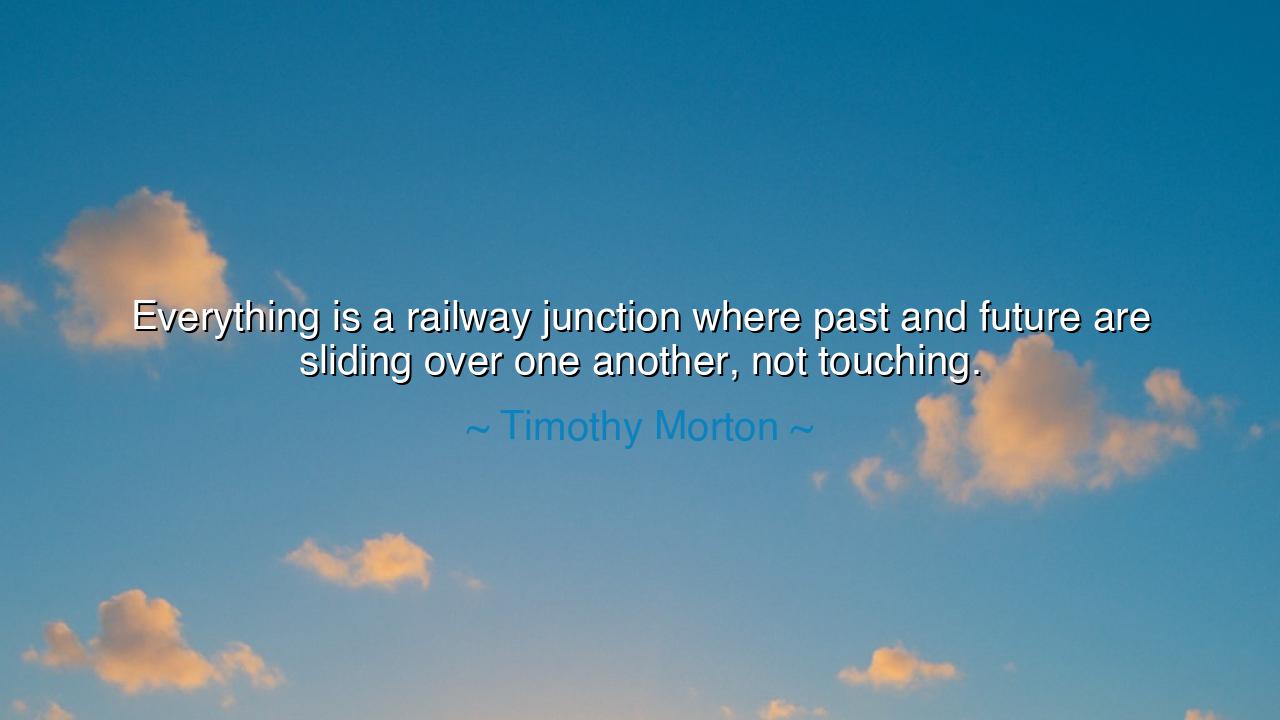
Everything is a railway junction where past and future are
Everything is a railway junction where past and future are sliding over one another, not touching.






"Everything is a railway junction where past and future are sliding over one another, not touching." These evocative words by Timothy Morton offer a profound reflection on the nature of time and our experience of it. Morton likens time to a railway junction, a place where two tracks—the past and the future—run parallel, seemingly close, yet never truly touching. In this metaphor, he reveals that the past and future do not intersect in a tangible way, but rather glide alongside one another, always in motion. The past is a memory, something that has already passed, while the future is an unknown, always ahead of us but never fully attainable. Morton invites us to consider how we experience time, not as a continuous flow but as a series of moments where the past and the future remain separate, influencing but never fully merging.
The concept of time, and the relationship between past and future, was deeply explored by the ancient philosophers. Heraclitus, a Greek philosopher, famously declared that "you cannot step into the same river twice." His teachings reflected the constant state of flux and change in the world, where everything is in motion and transformation is the only constant. For Heraclitus, the past and the future are not fixed, but in a perpetual state of becoming, never truly meeting in a definitive point. Like Morton’s railway junction, Heraclitus’ river symbolizes the transitory nature of time—where the past is constantly slipping away, and the future is ever on the horizon, but never fully realized. The present moment, then, becomes a fleeting intersection where the past and future continuously pass by, but never touch.
In the ancient Roman world, Seneca, the Stoic philosopher, had a similar understanding of time. He wrote that "time is the most precious thing a man can spend," acknowledging that our existence is shaped by the finite nature of time. Like Morton’s vision of time as a railway junction, Seneca recognized that the past is gone, and the future is uncertain. Yet, unlike the constant forward motion of the railway, Seneca argued that the wise person must live fully in the present, aware of the limitations of time and the fleeting nature of each moment. The lesson here is that while we cannot control the passage of time, we can choose how we engage with the present—as a point of intersection between the past’s lessons and the future’s possibilities.
The story of Odysseus in Homer’s Odyssey offers another insight into this philosophical reflection on time. Odysseus’ long journey home represents the struggle between the past and future. The past is filled with memories of war, glory, and loss, while the future remains a promise, filled with uncertainty and longing. Throughout his travels, Odysseus is constantly faced with choices that force him to reckon with the past and look forward to what lies ahead, but his journey is always defined by the tension between these two realms. The moment of arrival, when Odysseus returns home, symbolizes the elusive union between past and future—a destination that remains distant even as it is constantly pursued. His story embodies Morton’s idea of time sliding over one another, the past always shaping the present, and the future calling to be realized, yet both remaining separate in their own unique existence.
Morton’s view of time as a junction also resonates with the wisdom of Buddhism, which teaches that attachment to either the past or the future leads to suffering. The Buddha taught that the present moment is the only time in which we can truly experience life, and that clinging to memories or anxieties about the future only traps us in cycles of illusion and dissatisfaction. In the same way that the railway junction metaphor suggests that past and future do not touch, Buddhism teaches that our true peace comes from embracing the present and letting go of the need to reconcile the past and future. Mindfulness, as taught by the Buddha, encourages us to live fully in the present, recognizing the transience of all things and finding freedom in the now.
The lesson we learn from Morton, and from the ancient wisdom that echoes through history, is that while we cannot stop time or force the past and future to align, we can control our perspective on them. The past is behind us, a collection of memories and experiences that have shaped who we are, while the future is full of possibilities, but always out of our grasp. The key to living a fulfilling life lies in embracing the present moment, in fully engaging with the now, and in understanding that the past and future, while important, are always sliding past us, never truly intersecting. This realization frees us from the burden of trying to control or reconcile what has already happened or what may never come.
In practical terms, we can apply this wisdom by practicing mindfulness and accepting the impermanence of time. Rather than becoming overly preoccupied with what has been or what might be, we should focus on the moment we have—the junction where past and future meet, yet never touch. By fully engaging in the present, we open ourselves to the richness of life and experience, understanding that true peace comes not from waiting for the future to arrive or holding on to past regrets, but from accepting and appreciating the flow of life as it is. In doing so, we allow ourselves to live freely, embracing the transient nature of time and finding joy in the eternal now.






AAdministratorAdministrator
Welcome, honored guests. Please leave a comment, we will respond soon